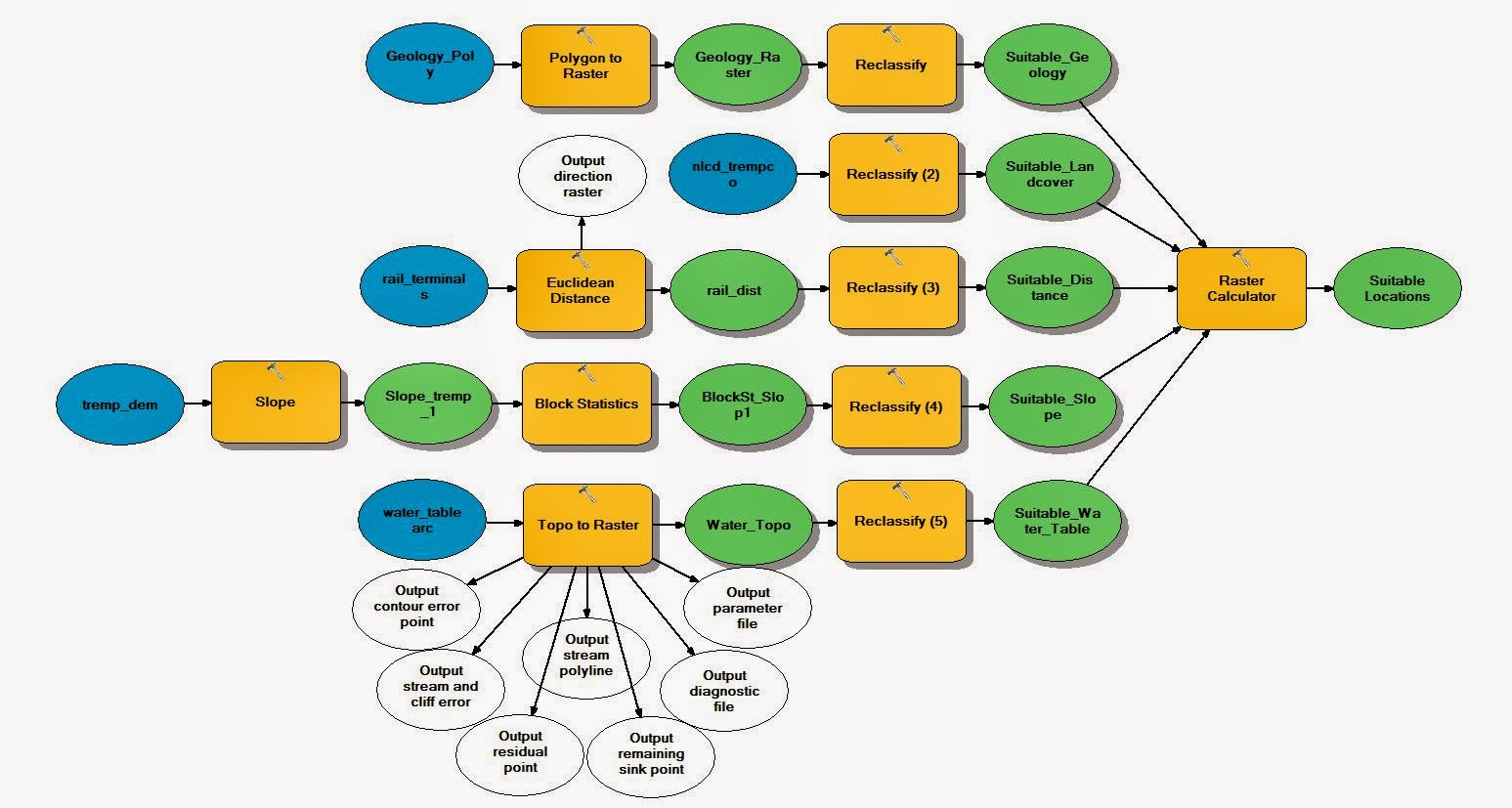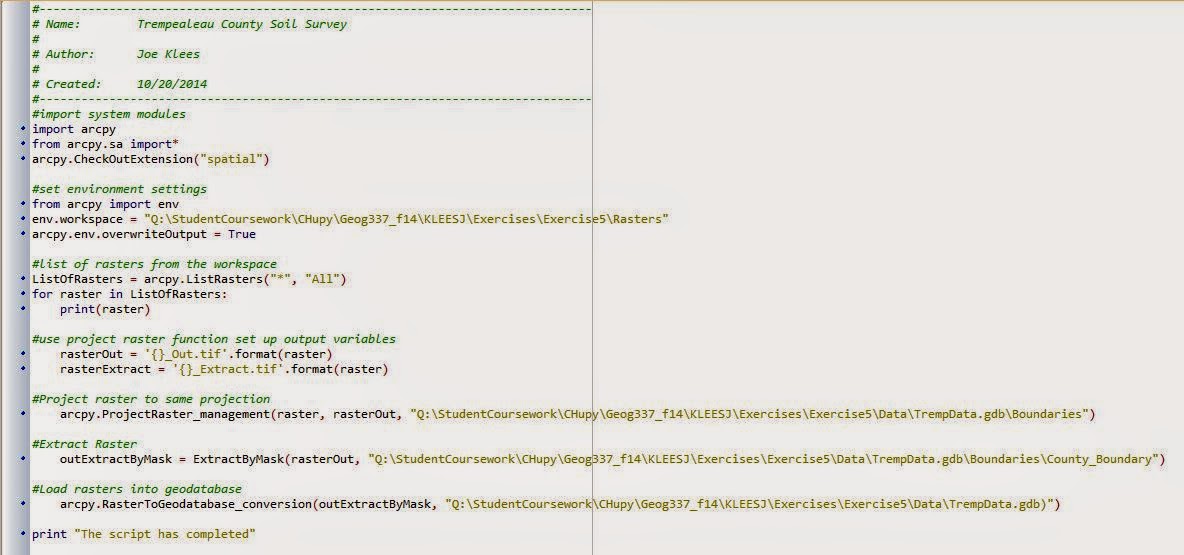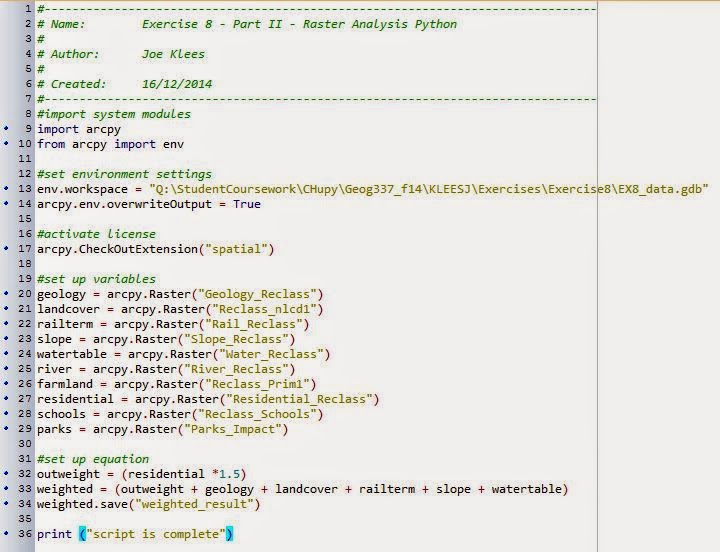Data Sets & Data Sources
Model 1
Geology - Wisconsin Geologic & Natural History Survey
Land Cover - USDA
Terminal Distance - DOT
DEM - USGS
Water Table Elevation - DNR
Model 2
All Data from Trempealeau County Database
Methods
Model 1
The first potion of the exercise had us creating a model to find the best locations will the criteria of geology, land cover, distance to rail terminals, slope, and water table depth. We categorized the criteria into 3 different groups best to worst with 3 being the best and 1 being the worst. The table below shows the characteristics of each criteria and the rankings.
| Table for model 1 with reclassified categories. |
These are the steps for each criteria for the first section.
1. Geology - I used a feature class of the different geology in the area from a map I imported into ArcMap. I then used reclassify to choose the formations that correlate with sand mining, the Trempealeau Group and Wonewoc Formation and give them a 3 (best). All others I gave a 1 (worst).
2. Land Cover - I took a raster of the different land cover in the area from the USDA. I used reclassify to put the barren land at 3, the shrub land at 2, and open water, developed land and forested land at 1.
3. Distance from rail terminals - I took I feature class of rail terminals in the area and used the Euclidean Distance tool to create a raster of the distance from the terminals. I then used reclassify to categorize them with the closest at 3 and farthest at 1.
4. Slope - I took a DEM of Trempealeau County and ran the Slope tool to create a raster of the percent slope. I then reclassified so the lower slopes were 3 and the steeper slopes were 1.
5. Water Table - I downloaded a water table contour line e00 file from the Wisconsin Geological Survey's website and imported it into ArcMap. I then performed a Topo to Raster tool to make it into a raster and reclassified it with the lowest water tables at 3 and the highest at 1.
 |
| Model 1 gives us the suitability of the area based on geology, land cover, distance from a rail terminal, slope, and water table depth. |
Model 2
Next we take a look at environmental and community impact criteria. (note all data was provided by the Trempealeau County Database).
| Table for model 2 with reclassified categories. |
1. Impact on rivers - For the first process I took a shapefile of the Trempealeau River and performed an Euclidean Distance around the feature. I then reclassified the distance with the most impact being closest to the river.
2. Prime Farmland - Next I looked at a feature class of the farmland and created a raster file from the feature class. I then reclassified it to show most impact to prime farmland, medium impact to potentially prime farmland, and least impact to non-prime farmland.
3. Impact on Residential areas - I took a zoning feature class and selected only the residential areas then performed an Euclidean Distance around just those areas. I then reclassified the data with most impact being within 640 meters which is hearing distance and then farther out was least of an impact.
4. Impact on Schools - Next I took a parcel feature class and selected the parcels owned by school districts. I then performed an Euclidean Distance on the data and reclassified them with the most impact being on areas closest to the schools.
5. Factor of choice - Parks - I chose to look at parks for my factor of choice and found a feature class in the Trempealeau geodatabase that worked. I performed an Euclidean Distance on the data and then reclassified the data with the most impact being on areas closest to the park.
6. Viewshed - Horse trails - I chose to use the trails feature class to perform the viewshed and specific chose the horse trails from the trails feature class. I used the DEM from the first section and found most of the area was not seen from these trails. I had most impact as visible and least impact as non-visible.
The model below goes through each of the steps above and then brings them all together with the raster calculator to find the areas that most meet the criteria. This section is opposite to the first section in that the higher the number the most impact the area has from sand mining and the worst that area would be for putting a sand mine in.
 |
| Model 2 gives us the environmental and community impact on rivers, prime farmland, residential, schools, and parks that sand mining would have. |
Results
So finally I needed to bring both sections together to find the ultimate sand mining locations. I reclassified the first section into three categories 0-5 being the worst, 6-10 being in between, 11-15 being the best. For the second section I needed reclassify the data but first needed to flip the numbers so that the higher numbers were least impact and the lowest numbers were most impact. I then categorized them as 0-5 being the most impact, 6-10 being in between, and 11-15 being the least impact. and with We then used Raster calculator to produce a index number based on all the criteria with the higher the number the more suitable the location would be for sand mining. Lastly, I performed a raster calculator to add the too sections into one raster.
The model below shows the steps to finally bring both sections into one map.
 |
| Final model to bring both sections together for the ultimate sand mining locations |
The maps below show the results for models 1 and 2 as well as the final model bringing both together into a final map.
 |
| Map of the suitability for sand mining based on model 1 |
 |
| Map of the environmental & community impact for sand mining on model 2 |
 |
| Map of both suitability and environmental impact for sand mining on both models |
Discussion & Conclusion - The maps above show the areas best suitable and non-impact for sand mining in Southern Trempealeau County. I think that this is a great model for finding a suitable place to build a sand mine (however it is not very realistic). I would find the areas that are recommended in the last map to be good locations they are far from residential areas and won't impact many other factors as well as being suitable for mining sand. I could see some companies using something similar to find a location however, with a lot more detail and more current data.
This overall project this semester has been very interesting and helped me greatly explore skills needed for GIS professionals. I cannot think of a better way to learn and master these skills than the exercises I completed this semester.
(See Python Blog Post for Python potion of this exercise.)













